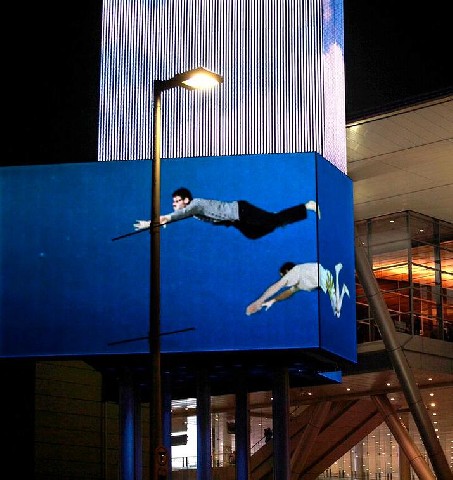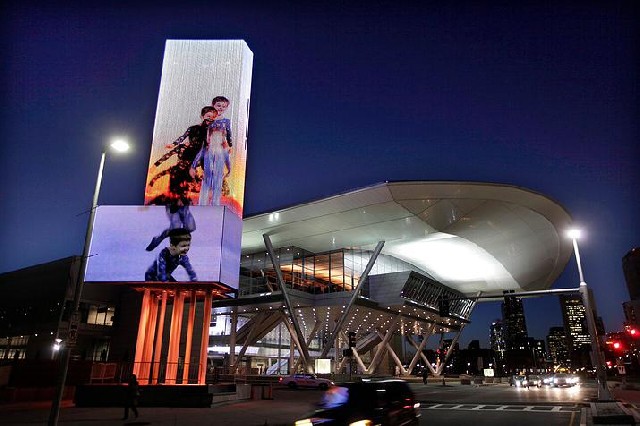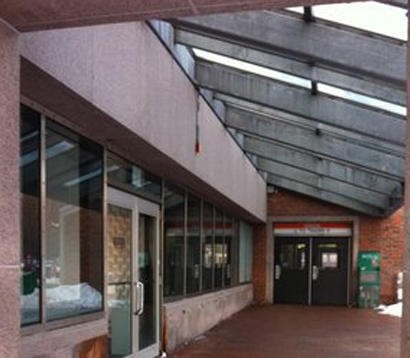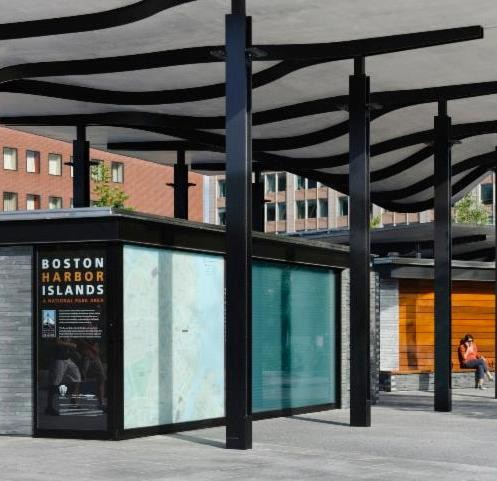Boston CyberArts Reaches into the Public Domain
From Desktop to Laptop to Public Art
By: Mark Favermann - May 26, 2015
Since cave artists first wanted to express themselves by painting cave walls, artists have been pushing the limits of creative mediums. The primitive cave artists first tested drawing with soot, the black from fire and from burnt bones. Then they wanted to add color, so they experimented with what was in their vicinity--earth pigments including red ochre, yellow ochre and umber. Throughout millennia, new materials and technologies have always been experimented with, refined and then further creatively developed by artists.
For the past forty years or so, artists have been using digital technologies as paint box, animation tools, projection imaging and sculptural framing devices. This phenomenon has gone from computer desktop to laptop to gigantic public art forms. Initially, this walked the line between engineering and design, not art. But over the succeeding years, these technology driven tools have morphed into highly visual provocative, creative artwork.
One of the strongest American cultivators of this digital medium has been George Fifield, the founder and director of Boston Cyberarts. It is a non-profit arts organization created to foster, develop and present a wide spectrum of media arts including electronic and digital experimental arts programming in Boston, New England and throughout the world.
Initially, Boston Cyberarts was founded to organize the Boston CyberArts Festival, a biennial festival begun in 1999 of American and international artists and high-technology professionals. The Festival included exhibitions of visual arts: music, dance, theatrical performances, film and video presentations as well as educational programs and lectures, demonstrations and symposia. The last one was in 2011.
One of the strongest American cultivators of this digital medium has been George Fifield, the founder and director of Boston Cyberarts. It is a non-profit arts organization created to foster, develop and present a wide spectrum of media arts including electronic and digital experimental arts programming in Boston, New England and throughout the world.
Initially, Boston Cyberarts was founded to organize the Boston CyberArts Festival, a biennial festival begun in 1999 of American and international artists and high-technology professionals. The Festival included exhibitions of visual arts: music, dance, theatrical performances, film and video presentations as well as educational programs and lectures, demonstrations and symposia. The last one was in 2011.
Currently, Boston Cyberarts administers the Boston Cyberarts Gallery. It is located in the Green Street MBTA Station on the Orange Line in the Jamaica Plain neighborhood of Boston. It is the only art space located in a working train station in the country, and also it is the only independent art gallery in Massachusetts focusing only on new and experimental media.
Cyberarts’ two prominent public art projects include the Art on the Marquee project and the Harbor Islands Pavilion project. Boston Cyberarts and the Massachusetts Convention Center Authority teamed up to create “Art on the Marquee,” a project that commissions public media art for display on the 80-foot-tall multi-screen LED marquee outside the Boston Convention & Exhibition Center in South Boston. As the largest urban screen in New England, this unique digital canvas is one of the first of its kind in the U.S. to integrate visual art alongside commercial and informational content. It is a key part as of the convention center’s neighborhood arts program.
“Art on the Marquee” offers artists more than 3,000 square feet of digital display on seven screens, providing full-motion video and a viewership of more than 100,000 pedestrians and motorists. The marquee is quite visible for a half a mile in many directions and is seen by traffic on nearby streets, as well as from the surrounding hotels and office buildings.
This amazing media art as part of the convention center’s marquee content is a model for future integrated signage and urban screens in both Boston and throughout North America. It certainly pushes the conventional marquee content into new visually stimulating and unexplored directions.
“This iconic project brings digital art to the streets of Boston” said Cyberarts Director George Fifield. This activity underscores urban screens becoming more and more ubiquitous worldwide and expands the use of dynamic digital displays for public media art. It literally animates one of Boston’s most rapidly developing public areas, The Innovation District.
Some recent artworks exhibited include: Metabolic is a series of visual studies on the unraveling of chemical reactions through space and time. This is collaboration between artists Marcelo Coelho, Nickolas Peter Chelyapov, and Sean Michael Dorian. Another is Climbing where the marquee became a colorful indoor rock climbing wall on which a parade of figures ascend. This piece was created by Corey Corcoran, a mixed-media artist and illustrator.
Also visual artist, filmmaker, and videographer Frank Floyd created Tennis Anyone? On the upper screens a tennis player serves a ball, in slow motion. Above him (perhaps in his own mind?) is the recently formulated equation for the perfect tennis serve. On the lower screens a squash player volleys with the ball seeming to bounce off the marquee itself. This action turns the marquee into a virtual squash court. And these are only just a few examples.
In addition, Boston Cyberarts has developed a curatorial program for the Boston Harbor Islands Welcome Center Pavilion. This project is in collaboration with the Greenway Conservancy, The Boston Arts Commission, and others. It solicits and selects algorithmic artists for the LED screens at the Pavilion during a 24-month pilot period. The resulting creative visual expressions enliven the Pavilion in the evening, while promoting the exciting creative innovation of the Boston area.
In an effort to directly relate to the Harbor Islands themselves, the commissioned artists draw from the national park’s geographic information system (GIS) databases as a source. However, the artwork is all abstract. This public program ties into the innovative strengths of the Boston area, using digital art algorithms to heighten the interest in Boston Harbor’s history and natural complex ecosystems.
Currently on view at the Boston Harbor Islands Welcome Center is Waves on Sea and Land, a generative art installation by Mark J. Stock. This real-time artwork uses live wind data from the Harbor Islands and techniques from computational physics to recreate two essential wind-driven motions of the islands.
The Harbor Islands are always in flux-- wind and tides scour and deposit sand and sediment, shorelines move while grasses and wildlife adapt to their dynamic environment. Waves on Sea and Land reflects these timeless yet ephemeral forces with a continuous, never-repeating simulation of two patterns of motion to be etched into the memories of the islands’ visitors.
A model for other cities in its fostering of the creative use of new media, in name as well as action, Boston Cyberarts is a significant 21st Century public art facilitator.
This article is being republished by permission of newmedia.international where it was first published.
http://www.NEWMEDIA.international






